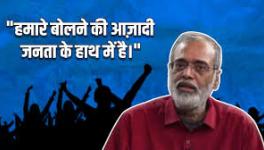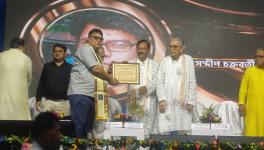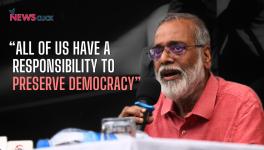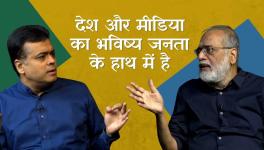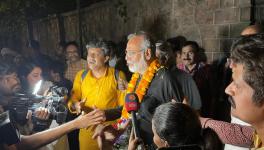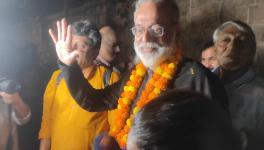The Spectre of ‘Knowledge as Commons’

On October 3, 2023, in an egregious violation of press freedom, the founder of the progressive Indian media company NewsClick, Prabir Purkayastha, was arrested on trumped up charges of accepting foreign donations in exchange for spreading Chinese propaganda. Purkayastha is a Monthly Review author, political commentator, analyst, proponent of open science and technology, and, perhaps most significantly, critic of the Indian government. Purkayastha’s arrest must be understood in the broader context of a crackdown on press freedom in India as a means of shoring up the hegemony of Narendra Modi and the governing Bharatiya Janata Party (BJP), an issue that Purkayastha himself has analyzed in both his book on Indian politics, science, and technology, Knowledge as Commons, as well as in his fascinating new memoir, Keeping Up the Good Fight (both published by LeftWord Press, 2023). Knowledge as Commons in particular lays out a vision of an inclusive, secular nation based on the open sharing of knowledge that is directly at odds with the political reality in India today.
Purkayastha’s account of the progressive politics that technology and open knowledge make possible, his vision of knowledge as the “common heritage of humankind,” and his opposition to the enclosure and privatization of that knowledge have made him an oppositional figure in Modi’s India. In a political conjuncture predicated on division, differentiation, hierarchy, and the oppression and silencing of minorities, Purkayastha’s vision of science and technology as fundamentally inclusive is a radical one. It is also of a piece with his vision of the power of an independent and critical media. This explains the Modi regime’s hostility to Purkayastha personally, to the activities of NewsClick, and to the sophisticated linking of science, technology, and progressive politics contained in Knowledge as Commons.
When Purkayastha established NewsClick in 2009, the news outlet explicitly focused on covering marginalized voices in Indian society. Support for previously silenced people went along with a need to speak to the “new video generation,” for whom print media was already obsolete. If this kind of intergenerational and progressive communication did not take place, Purkayastha contended, then the younger generation “would be lost to a different kind of politics.” NewsClick was intended to be both the mouthpiece of forgotten voices and the bridge between an older progressive politics and the younger generation in India.
The politics that NewsClick aimed to combat was the authoritarianism shared by both Indira Gandhi’s Congress during the 1975–77 Emergency (during which Purkayastha, then a student, was jailed for a year) and the current state of Indian politics and culture. Despite differences in their practical response to opposition, their ideology, and their political worldview, both the Congress of the Emergency and Modi’s government rely in particular on the repression of press freedom to achieve and support their hegemonic projects.
In the opening chapter of Keeping Up the Good Fight, Purkayastha asks whether every generation has to face an Emergency such as his did in the mid-1970s. Purkayastha is of the generation Salman Rushdie called “Midnight’s Children,” coming of age in the aftermath of independence and partition, and he is concerned with placing two “aberrant periods”—the Emergency and the current juncture—in the broader context of “75 years of the secular, diverse, democratic, constitution-guided republic of India.” Despite their political and ideological differences, what connects the Emergency with Modi’s India is precisely their subversion of the promise (and reality) of independent India.
Purkayastha uses the restriction of press freedom as a way to draw out the similarities between the two periods. If “Emergency” is understood as “a general description of repression,” it is one that develops when those in power are intent on eroding “fundamental rights.” This describes both the 1970s and today. Beyond this broad characterization, it is vital to bear in mind the way in which the two periods contrast. The ideology of Indira Gandhi and the broadly liberal Indian National Congress was distinct from the far-right religious nationalism of the Rashtriya Swayamsevak Singh (RSS) and its successor, the BJP. Modi played a major role in the RSS’s opposition to Congress during the Emergency before rising in the ranks of the BJP and becoming prime minister in 2014. Purkayastha identifies two main points of difference between the Emergency Congress and the BJP of today: a politics of exclusion and communitarian violence and an attack on secularism. The object of the Indian state and its Hindutva supporters today is to “help build a kind of destructive and sectarian politics… to exclude people on the basis of their community, to the extent of eroding the citizenship rights of some Indians.” Purkayastha insists that while “the Congress did not have all these exclusionary politics in its genetic composition; the RSS [and therefore the BJP] has them in its genes. That’s the crucial difference.”
The attack on secularism takes the form of specific attacks on culture, education, science, and reason, with the RSS-BJP rejecting the promise of post-1947 India and the “inclusive, secular nation with a scientific outlook envisioned by so many of our freedom fighters.” Rather, they want to turn back the clock to the period of partition, and to continue fighting against Muslims for Hindu supremacy. For Purkayastha, inclusivity and solidarity are vital weapons in the struggle against BJP’s vision for India, which is why NewsClick’s mandate of building relationships and promoting minority voices is both so important and so threatening to India’s ruling elites. Reflecting on combined resistance from Muslim and Jat farmers to BJP maneuvering in 2013, he argues that the kind of unity that this pushback represented is in itself a threat to the division fostered by a right-wing politics intent on making solidarity movements impossible.
In both 1975 and in the current moment, repression of press freedom is a major tactic in the government’s response to such challenges. But, whereas the media in 1975 was cowed by the government into subservience, the media today is much harder to control, due both to a changed media landscape (in particular the change from print to digital and the proliferation of smaller news outlets) and the rise of social media. Indian media has now become much more difficult to control than in the 1970s, which explains why “despite the best efforts of the BJP and Modi acolytes, you do hear other voices.”
This relative uncontrollability means that the blunt instrument of direct censorship that worked to bring the media to heel in the 1970s is no longer sufficient. The technological changes that transformed the media landscape require new approaches, and particularly the regular harassment of prominent opposition media outlets in order to “make an example of a few to create a chilling effect [in which] self-censorship becomes the norm.” Among the differences between the repression of the Emergency and repression today is that whereas Indira Gandhi’s government sought to take control of the media and to marginalize or defang its opponents, the Modi government seeks to erase opposition altogether, “to remould the state without these dissident voices; and ensure that nobody is able to stand up to the government or the rightwing forces in all their various avatars.”
Purkayastha identifies the use of First Information Reports (complaints to the police) as an important mechanism in this dynamic of harassment and silencing. His arrest in October 2023 is only the latest incident in the Modi government’s quest to control NewsClick and Indian opposition media more broadly.
In August 2020, a First Information Report was filed alleging that NewsClick broke foreign investment limits. This was followed in February 2021 with a raid on NewsClick premises on suspicion of money laundering. Allegations of funding for pro-Chinese propaganda began in August 2023, when the Indian police linked—for the first time—the earlier charges of foreign funding and money laundering with the specter of pro-Chinese propaganda.
The immediate trigger for Purkayastha’s arrest (along with forty-five other NewsClick associates) was a story published in the New York Times connecting Indian media companies, including NewsClick, to tech entrepreneur Neville Roy Singham and, it was insinuated, the Communist Party [of China]. Journalist Kavita Krishnan wrote that the Times story “has become a pretext to escalate an ongoing campaign to persecute and imprison some of India’s most courageous journalists, academics and activists on baseless charges of abetting ‘Maoist terrorism.’” Krishnan’s use of the word “escalate” is significant. The way the individual charges were promoted from a fairly anodyne transgression (exceeding investment limits) to illegality (money laundering) to the threat of direct foreign interference (“Maoist terrorism”) is an important element in the way we can understand the mechanisms being used by the Indian government in order to control and repress opposition to its own hegemonic (“Hindu nationalist”) designs, including the demonization of certain segments of the population and the creation of moral panics.
The concept of moral panic is central to cultural theorist Stuart Hall’s analysis of the rise of right-wing UK politics in the 1970s and ’80s. Hall’s account of how hegemony is maintained through consent and coercion, derived from Antonio Gramsci, is relevant to Purkayastha’s characterization of the differences and similarities between the 1970s and the present. To put it briefly, Hall identified the ways in which the state and the media in the United Kingdom worked together to identify certain demonizable “folk devils,” who could be portrayed as threats to “traditional” British values, beliefs, and ways of life. These included those who supported collective action over individualism (for example, the trade unions and the left); those who belonged to “alien” cultures, which allegedly did not respect individual rights and freedoms (including ethnic minorities, immigrant groups, and so on); and those who did not uphold individual responsibility and autonomy (for example, so-called welfare scroungers). Hall demonstrated how division and scapegoating, particularly by police and a docile media, could be used to create and instill a new common sense that supported the hegemony of the British state through the fostering of division and the oppression of marginalized communities.
Hall also identified a series of thresholds that mark escalations in the state response to perceived threats or challenges. These thresholds are departures from societal norms as defined and maintained by ideology and propaganda, ranging from permissiveness (a violation of a norm that draws a censorious or disapproving response in order to bring the transgressor back in line) to illegality (breaking the law, which draws a law-and-order response from the state), to actual or potential extreme violence. A particular challenge to the state can be made to appear more threatening if it can be combined with other, larger threats, and this process of escalation allows the media and the state in turn to step up the police response.
With this in mind, we can better understand the significance of the police’s linking of NewsClick’s transgression of “permissiveness” (exceeding funding limits) with a transgression of illegality (money laundering), and then to the threat of real violence (“Maoist terrorism”). That these links were discursively provided by a liberal media outlet as commanding as the New York Times helps makes the case for moral panic and allows the Indian police to represent themselves as responding to, rather than creating, the conditions for media repression, including the arrest of Purkayastha himself.
Both Purkayastha and Hall were influenced by Louis Althusser’s work on ideology, and in particular with the way “Ideological State Apparatuses,” including the media, can construct an audience for hegemonic values and ideas, and then appear to consult that audience in order to gain a measure of popular legitimacy for the government’s own repressive policies and actions, thus allowing a society to “drift”—in Hall’s phrasing—into increased state repressiveness. Hall called the result of this tendency “authoritarian populism,” which differs from older, more directly coercive authoritarianism in the same way that Modi’s populism today differs from the 1975 Emergency.
What Purkayastha identifies in the differences between media repression during the Emergency and today is the contrast between relying on physical and material coercion without requiring that opponents think a particular way (utilizing, for example, censorship, among other methods), and the manufacture of consent via a new common sense—one aligned with the BJP. The latter is built not only around the propagation of government messaging through docile media outlets, but through the construction of moral panics focused on demonized, excludable Others who can be portrayed as enemies of “our” traditional values and ways of life. While the BJP historically has relied on the demonization of Muslims, Dalits, Adivasis, women, and secular activists, the opportunity to vilify “enemies within” is too good to resist, especially when those enemies have (like NewsClick) actively promoted the voices of other “folk devils” of BJP ideology.
In short, it is no longer enough to control the printing and dissemination of media through censorship while allowing opposition media to remain. What is necessary in today’s India is to control the thoughts that people have, the way they think about things, their worldviews, ideas, and opinions. In the 1970s, Congress relied on what Althusser called “Repressive State Apparatuses”: through censorship, media outlets were prevented from disseminating the news, but could otherwise think what they liked. Today, in the context of broader moral panic for hegemonic ends, the Indian government has focused on Ideological State Apparatuses to get people not only to go along with Hindutva, but to believe in it. To clear the way for this to happen requires not just the repression of a free media, but its erasure.
Purkayastha’s memoir weaves together two aspects of his experience that today may seem like strange bedfellows: the experience of Marxist community organizing and activism, together with computer engineering. His political journey began with the Communist Party of India (Marxist) in 1970, in the heady mix created by the events of ’68, German and Italian communist agitation, and the US antiwar and civil rights movements. Purkayastha gained experience on the shop floor and in student politics, and, under the influence of his reading of Althusser during his time at the Indian Institute of Technology in New Delhi, he began to combine his political and technological thinking. Althusser’s conception of Marxism as a science closely paralleled what Purkayastha understood as the relationship between science and technology itself. Technology, in this view, is not an “applied science” related as praxis to theory, but a relatively autonomous field of human endeavor, which, like all human endeavors, can only be politically progressive if it is truly inclusive.
Free/open science and technology, such as the open-source software movement, are examples of Purkayastha’s holistic view of promoting marginalized voices and the forging of solidarity among communities. The privatization or enclosure of knowledge through intellectual property laws and patents is not only ways of commodifying knowledge to ensure profit, but of restricting its spread and, therefore, its positive social effects. Purkayastha’s vision of open science and technology, unrestricted by capitalist property relations, is of a piece with his vision of a progressive media. It is through the sharing of knowledge, particularly knowledge by and of marginalized or oppressed people, that solidarity movements can be forged, and the secular democratic promise of the republic achieved.
The main conceptual innovation in Knowledge as Commons is the “conceptual independence” of technology from both science and the political projects that use technology as a means of domination or oppression. In its relations to science and to politics, technology is often seen as grubby, dirty, sordid, or inherently oppressive. It is this view that Purkayastha seeks to overturn in order to restore a sense of the inclusive and progressive potential of technology. Purkayastha traces the development of a divide between science and technology, with technology understood as, at best, “applied science,” but more often as a kind of impure materialist activity that gets its hands dirty. If “the objective of science is to know nature,” Purkayastha writes, technology “starts with the objective of building an artefact; in other words, of changing nature.” In effect, the standard philosophical view of technology charges it with an inherent Prometheanism and with the instrumental domination of nature required by capitalist development.
Science, in this view, would prefer to keep itself distinct from the materialist, world-changing concerns of technology, especially given the history of technology in the twentieth century. Drawing on the examples of the Nazi gas chambers, the Bhopal disaster, and the atomic bomb, Purkayastha suggests that not only are such evils considered “inherent in the vision of technology,” but that science itself risks being “thought to share the ideology of dominance over nature that characterizes technology” since in the twentieth century, science became “a virtual synonym for technology.” From a Marxist perspective, of course, oppression and domination are not inherent in a given technology; technology is put to use by particular political programs. This is not to say that a given technology is historically or genealogically neutral, but that an understanding of technology at a particular historical moment requires an understanding of the politics of that moment.
Indeed, there is a class question at the heart of the science/technology split. Purkayastha writes that “From the slave societies of Greece and Rome, to the caste-driven society of India, the world of artifacts has been separated from the world of ideas. Scientists and mathematicians could enter the world of ideas, but not those who worked with their hands. The European aristocracy, first slave-owning and later land-owning, despised labor and, along with it, the instrument of labor—technology. So did the upholders of the caste system.”
Any progressive politics must not only obliterate the distinction between “the head and the hand” by allowing technology workers entrance into the world of ideas and vice versa, but must overturn the enclosure and privatization of knowledge in order for knowledge itself to become “the common heritage of humankind” and for science and technology to “belong to all of us, as human knowledge in the global commons.” Purkayastha’s criticism of intellectual property and patent regimes as the enclosure and privatization of this common heritage of knowledge stems from a more inclusive, less divided vision of science, technology, and knowledge itself.
But Purkayastha goes beyond these fairly orthodox Marxist points, arguing that in fact there is a real reason for keeping science and technology conceptually independent from each other. Each domain has different goals and objectives. While in Purkayastha’s view, “scientific activity discerns laws, classifications or patterns in nature” that are the basis of explanation and prediction, the primary goal of technology “is to produce artifacts that incorporate some…social function.” This means that science is an epistemological activity with very different processes, goals, and objectives than the practical activity of technology. Purkayastha does not deny that science and technology are practically inextricable (science needs technology to do its work, technology produces new knowledge about the natural world that feeds back into science), but argues that they should not be confused conceptually.
The main impetus for this account is that whether technology is seen as “violently subjugating nature” or as “derivative of science,” neither view conforms to the way technologists actually work. Purkayastha argues that technology is neither an inherently oppressive or dominating force simply because it is technology, nor is it simply the physical manifestation of scientific knowledge. The first extreme sees technology as having an agenda or playing a role of its own, separate from the social and political context that generates it. The second sees technology as merely the passive recipient of scientific knowledge. In the first case, too much autonomy is granted to technology; in the second case too little.
A helpful contemporary example is provided by current debates over so-called artificial intelligence (AI). For “doomers,” modern generative AI tools such as large language models (for example, GPT) have goals and outcomes unknown by and independent of human beings and our social relations—that is, the social and political matrix that has produced the tools in the first place. Conversely, AI utopians see such tools merely as the reification of cutting-edge scientific knowledge, and therefore nonthreatening. By conceiving of science as neutral and apolitical, these utopians refuse to recognize the social and political misuses to which AI technologies can and will be put. In both cases, however, science and technology are conceived of apart from their social, political, and economic matrices. Purkayastha restores the notion of “people” to this curiously depopulated landscape. Not only are social and political realities part of the “design space” of any given technology, but social realities are also an inherent element of science as well. Purkayastha writes that “technology choices are also social choices. This is why the choice of technology cannot be left to a technocratic elite.”
Such issues are prevalent in today’s technology landscape, legible in tech entrepreneurialism’s “longtermism,” eugenics, and “effective altruism.”22 Purkayastha sees technology deployment in the contemporary global conjuncture as encouraging the same kind of divisions (class, caste, racial, gender, and so on) as Modi’s government is fostering in India. It is only the supposed neutrality of technology that makes it appear as something other than the product of concrete social and political decisions, made possible by the privatization of scientific and technological knowledge through mechanisms such as intellectual property rights and patents. Universalizing knowledge, producing “knowledge as commons,” is really the same project engaged in by NewsClick: the overcoming of gaps, the building of bridges, and the restoration of power to “the people” conceived, not in a particularist, populist, or nationalist way, but in a universal sense. In the concluding chapter of Knowledge as Commons, Purkayastha makes clear the connections between the essays in that book and in his memoir, Keeping up the Good Fight:
It is not where you produce, but what knowledge you have that determines winners and losers in today’s global economy. Developing its people is the key to the future development of a country. This is why any nationalism that defines itself through a land, and not its people, belongs to the past. A scientific vision of the past and of the future is key to this fight. Giving up knowledge in the belief that the ex-colonial powers will readily hand it to us is a project for the re-colonisation of India. This is why we have to fight.
The need to struggle for a more inclusive and democratic society lies at the heart of both Purkayastha’s books. In Keeping Up the Good Fight, he details the events that led him to understand the value and necessity of struggle; in Knowledge as Commons, he lays out his philosophy of knowledge, science, and technology as the open and collective heritage of humanity. In a clear example of the direct connection between theory and praxis, Purkayastha has, through NewsClick, demonstrated the importance of open knowledge sharing and the relevance of collective struggle against authoritarianism. It is easy to understand why he posed a threat to the Indian state severe enough to warrant incarceration, a threat made concrete in his theory and his practice, and the role played by the New York Times in the attack upon him. It is also easy to understand why his arrest raises a chilling specter for progressive politics globally.
As of this [publication] in March 2024, Purkayastha remains in jail.
Sam Popowich is a librarian at the University of Winnipeg, Canada.
This article was originally published in Monthly Review.
Get the latest reports & analysis with people's perspective on Protests, movements & deep analytical videos, discussions of the current affairs in your Telegram app. Subscribe to NewsClick's Telegram channel & get Real-Time updates on stories, as they get published on our website.











